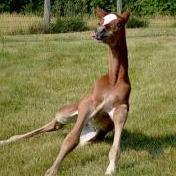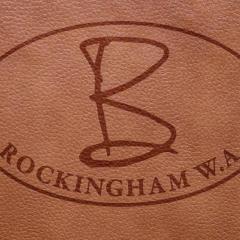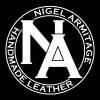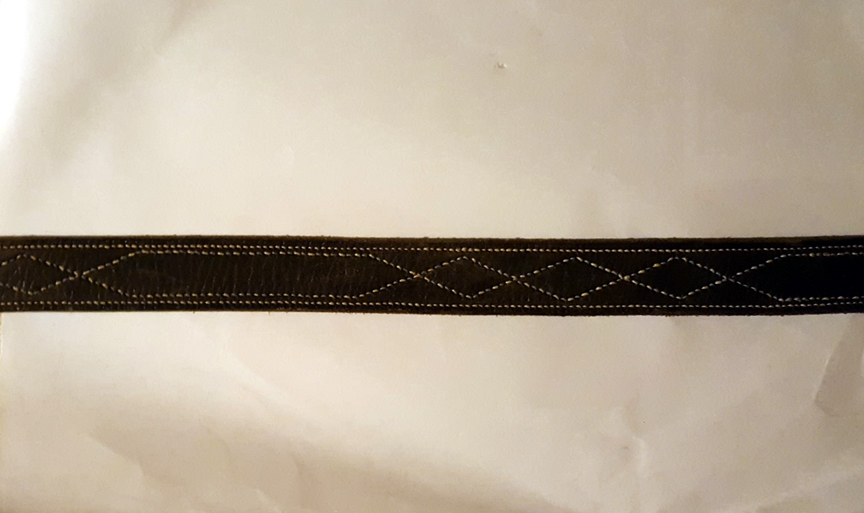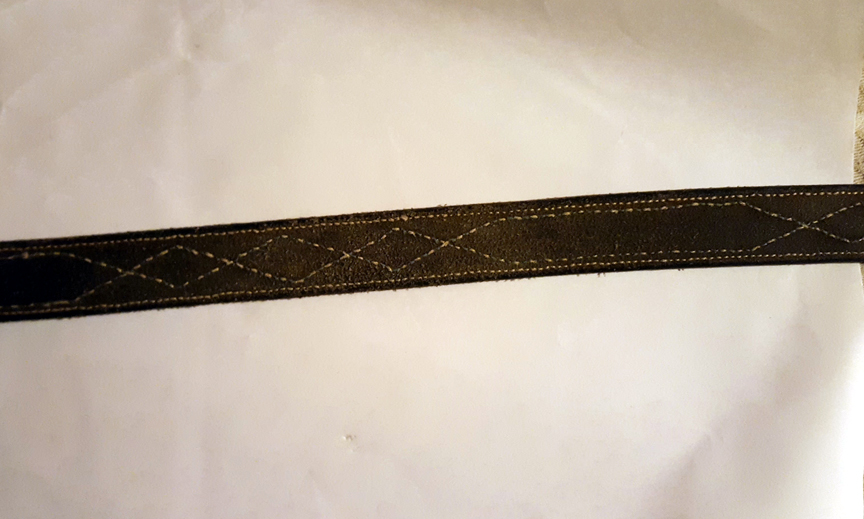-
Posts
79 -
Joined
-
Last visited
Profile Information
-
Gender
Male
-
Location
UK
-
Interests
huntin' shootin' fishin' falconry horses
LW Info
-
Leatherwork Specialty
saddlery
-
Interested in learning about
tooling modeling dyeing etc
-
How did you find leatherworker.net?
chance search on Google re dyieng
Recent Profile Visitors
5,446 profile views
Birdman's Achievements

Member (2/4)
-
I do not consider you a victim. I have been polite in all my postings. I have patiently explained my reasoning's, and listened to yours, explaining why I did not agree. I have treated you you as someone who is keen to produce good work but may not have had the advantages that I had in learning the job properly. That was evident from the advice you offered the OP. That advice would/could produce a poor stitching line, strength of stitch and damage to his tools. Awls are not made to be pushed through leather into a piece of wood. I have not referred to your alignment skills. The tools have been clearly placed on the marked line at either end of the tool(s). I DID refer to the marks left by the tool. And that IS highly relevant. It is the tool that is out of alignment, that is if the marks shown were made in one action using that tool. It has quite clearly got bent and damaged prongs. As I said, it is not fit for purpose. And if the tool is in good order, why are the resulting marks/holes all over the place? The piece of stitching I have shown, a belt, the first item I made looks fairly straight stitching to me, especially as a first attempt. Bear in mind this belt is 48" long, has two rows of stitching both sides, at 8 and 10 spi using different colours through 3 to 3.5mm bridle leather. It was made in October 1988 (typo in earlier post) and has a reasonable amount of use since. So even with the belt now having a curve, bends and knocks from use, that stitching still looks pretty straight to me. My way is not the only way, ( as you say) but it is arguably a better way, it has stood the test of time through a whole range of leather products. And it is definitely a better way two join two pieces of thick leather than that which you advised---- which was the question asked by the OP. Another minor point----you mention sharpening awls. Do you know, unless I have dropped an awl on the floor and bent it, I have never ever had to sharpen an awl. My first awl has shortened by 1/3 and worn so thin that it is now unusable for bridle leather. But its a dainty little tool for the 1mm stuff!
-
Thanks for the comprehensive reply, and taking the time to produce the pictures. Regarding my reference ( and your reply) to machine stitching and its comparison with stitching chisels, you have missed my point. I was comparing the effect of a machine needle punching a hole through the leather as being similar to a stitching chisel in cause and effect. It leaves big holes, and big holes cause weakness and fail to grip thread. Other threads on this forum make a point of advising not stitching across a strap holding a buckle because it weakens the leather......I wonder why? With regard to hand stitching/machine stitching and tensioning, you have missed the point. The next issue was one of the nuances of tensioning by hand, versus by machine. Even if you could empirically prove that hand tensioning provides stronger stitching than machine stitching, you'd still be a million miles away from showing that holes made by a chisel over an awl, affect the tensioning of a hand stitch in any meaningful way. If the holes are butchered and to big, when stitching, the leather does not close over the thread and grip it, so to achieve a tight stitch the worker pulls tighter, and runs the risk of a 'dead man' or a does not pull tight enough and gives a loose stitch. A machine is set to a tension, it does not adjust that tension as it progresses along the run, it does not feel the changes in the leather. ( As I pointed out earlier.) A pair of skilled hands do.This is part of the skill acquired by learning to stitch properly in the first place--and is pertinent to my first post to the OP. With reference to the my part regarding the possible invention of stitching chisels in history, again you have missed the point. No a stitching chisel is not a pricking iron. The idea would almost certainly have been born as a result of a pricking iron being whacked, and then the iron modified in the manner you suggest. It is a crude tool to short cut work. The pictures you have shown, in my opinion, show butchered leather in all cases. Starting with the first pic, first row...the pricking iron. The marks would indicate that the iron is not fit for purpose and/or your use of the awl leaves a lot to be desired. The row of marks are not level, and each individual mark is different from the others and the spacing is uneven---although the later may be the effect of camera positioning? The picture of the back of the iron and awl reinforces the argument. I suggest the there is indentation around each mark either from the iron or from the awl. You do not need to push the awl for the full length to take the thread. If the leather is very thick, you may have to use more of the awl. But that is where the correct training kicks in. Here ya go, a trick I learnt when training, ---- for free! (it cost me!) Punch a small piece of panel hide and thread it on the awl up to the handle---it will stop that indenting/ bruising. The work done by the chisel. The pictures of the chisel work show indentations of the leather--a good pricking iron will just leave a prick to guide the worker---and it will be evenly spaced, of uniform size and shape. The chisel marks are an improvement on your pricking iron! But they are still lacking slightly in uniformity and very slightly in spacing (see marks 1,2,3 compared to rest). They are also VERY long marks for 5 spi. You would need rope to fill them! Just a thought, I wonder why good pricking irons are several times more expensive than stitching chisels..........? It couldn't be the craftsmanship could it? I know if when I have bought them, I was unhappy with the mark, it would be re ground for free... Try that one with a cheaper imported tool! My tutor (former Giddens senior saddler) objected to the general quality of the mark and overall effect on the leather and its effect on the resulting stitching. He had a similar view of pricking wheels! I did find one in a boot sale that he did approve of, and he let me use it on some fancy stitching on the panel of a race exercise saddle..... it really did make a good evenly spaced mark---he even offered to buy the tool! Show me a stitching chisel that can produce holes for stitches using 3/40 or 3/25 at 10/12/15 spi and the leather is not full of 'dead men' or even torn off...... I accept that a chisel may have its uses with thinner leathers where stitch security is not important, but looking at the pictures you have submitted, nothing like that would leave my workshop. My original post still stands, it is better for a beginner to learn to stitch properly from the outset, using the correct tools to enable him to learn properly. They can then make their own decisions as to whether a pricking iron or a stitching chisel is suitable.
-
Sorry about the missing post above. I do not know what happened----and it took me ages of 2 finger typing as well! Not only that, the software does not let me use the "quote" facility either! I will try and cobble it together again. "Sorry to those who disagree, no offence intended, but I think the suggestion that chisels somehow weaken the stitch, is absolute nonsense. Anecdotal opinion isn't enough, I'm afraid I'd need some evidence to convince me otherwise. " OK. So lets try some circumstantial evidence. Man working with leather has been going on since the stone age. (OK I was NOT there) Particularly post the Industrial Revolution, I do not believe that the use of a Stitching Chisel would not have been tried. It is after all a very small step from giving a pricking iron a gentle tap with a rawhide mallet to whacking it through the hide with a hammer! I would suggest that it was tried for reasons of economy (time costs money in a competitive industry), and found to be lacking with long term use, and subsequently lost customers. Reference was made to machine stitching. I will continue with the analogy, it is another cost cutter and the actions of the machine needle have a similar result on the leather ie it punches a hole as opposed the the awls slicing action. As a saddler I have had many machine made items brought to me for repair. Common problems are stitching failure with head-collars and saddles. When machine stitching fails, it runs like a ladder in a ladies stocking. As a result, far more replacement (hand) stitching is required to make good than if the item was hand stitched. Worn hand stitching does not 'run', and the area of insult remains relatively small to the insult. It is also impossible to use a machine to match the new stitches with the old stitch holes.....and holes they are. I suggest that holes made by a machine needle are following a similar path to the use of a stitching chisel? The machine cannot detect the finer differences in a piece of leather like the experienced hand and eye can. It ploughs on regardless. Similar to punching holes and then using an awl in a vertical stance on to a piece of softwood on a bench to open the hole to allow 'lazy way' double hand stitching? This brings me on to replacing rubber grips on reins. If the rubbers have been machine stitched, you can generally only replace the rubber using machine stitching once. The punching needle does so much damage that the rein becomes unsafe---the holes join up! And they are holes! Years after the original work, on replacement of the rubbers, you can hold the naked rein up to the light and see stars! Rubber grip reins that have been hand stitched can be recovered about three or four times, Machine stitched reins can be recovering by hand stitching once, and if you are lucky maybe twice before it becomes unsafe to do so. I suggest that there is little difference between the effect of a machine needle and a stitching chisel? Western tack has been mentioned. Something that I have little experience of except for basic repairs. Western tack evolved because the cowboy needed equipment that could be repaired and made good miles away from the town. So it was made as simple as possible. It has subsequently evolved into a wonderful art form---far away from its original purpose. I had a Western saddle brought to me for repair.. It was just a basic working saddle with some embossing on the cantle. The flaps had been from two layers of thin leather, machine stitched around the edge, to produce a flap of the correct substance. --- Cheaper than a single piece of the appropriate thickness? The stitching had failed where the riders leg rubbed the flap edge, and then run. As a result, I had to re stitch most of the edge of the flap. And yes the stitch holes were evident and the leather somewhat pappy around the edge----but in fairness, this may have been due to the leather quality. But the point is....initial money saving resulted in higher later costs. So Martyn, in summary, nothing is new in a craft that has been around for centuries. Economics and competition will always drive cost cutting. Proven methods will always out last the the new fangled methods if those methods are shown to be inferior in the long term. So if you are making a quality product by hand, and especially if you adding value by some cracking arty stuff, its a shame to spoil the job for the sake of a ha'p'orth of tar. Because your customer will not be back if the stitching fails on his £80 ornate belt or guitar strap after a couple of years. Inbuilt design obsolescence should not be part of the quality built in to hand made leatherwork.
-
Yes, that is a fair point. No, I have never used them. But I have had their use and effect demonstrated to me when I was training. Conclusion of all was that they were unsuitable for saddlery use. If used lightly as a pricking iron, the marks were unsatisfactory---poor shape and spacing, if used as a stitching chisel, they still had the poor shape and spacing and left the leather butchered. The Master had made his point. (pun intended) I wouldn't use stitching chisels, I know how to do the job better, and I would fear the ghosts of ancient saddlers visiting me in the night with burning awls and flocking irons! I still think it is better to first learn to do stitching well using the correct methods and tools and then adapt as suitable for an individual project. Because once you can do it properly, its easier and faster than other methods that may only be suitable for some projects. For instance, a saddler is not going to abandon the use of pricking irons, awls, clams and double handed stitching and use a stitching chisel and poke the awl down through the leather to a piece of softwood on the bench just because he is now making a slip case for spectacles ---a job that doesn't need the same level of skill and security as a bridle ! But be my guest, you make something 'your way' where the stitching counts, like a bridle/standing martingale/stirrup leathers/girths/girth straps and then use them yourself..........And if the proverbial hits the fan, you will have the answers as to how significant the differences are.
-
Pabs--I trust you have your reply? The only points I would expand on is the tensioning of the thread and the treatment of the awls. The latter first. I would not let anyone use my awls (or any other tools for that matter) that pushed them down through the leather on to the bench/block of softwood/ wad of leather etc. Apart from the damage to the awl, unless the leather is quite thin, it must be difficult to get the same 'strike' with each (hand) action, unlike the use of clams or a pony. And your initial Q was for 2 layers of thick leather? With regard to the thread tension, the traditional methods that awls clams etc with any method of stitching (double hand, back etc) allow the hands to tighten the thread as you work. With experience ---and it doesn't take long--- the stitcher gets a feel for just how tight he can draw the stitch up. The worker feels the leather with his awl as he works and can adjust his pull accordingly, thus eliminating slack stitches and 'dead men'. Hides are not uniform throughout their area. Some bits are softer/thinner/more greased/have a resinous structure and so on. The awl quickly detects the slight differences along a piece of leather. The awl not only allows for the needles to go through your thread, it becomes a sensitive probe---part of your senses and 'gut feel'---the art and craft of the job. With double hand stitching, the tightening process not only tightens the stitch that is actually being made, but that of the stitch previous and the ones before that. Try it and watch carefully as you tighten, you will see the earlier stitches tighten slightly. The slice of the awl quickly allows the leather to return and grip the thread---in seconds. If using a stitching chisel to punch holes, this does not happen so easily, the holes may have already closed if the chisel work has been light and require re opening, or may need some seating after stitching in order for the hole to close. ( see earlier posts) Martyn quite correctly pointed out that not all leather work is saddlery. But I respectfully suggest that using the traditional methods and tools correctly, the resulting stitching can accommodate all areas of leather work. But by using other less professional methods, the same is not true. ie, I would be quite happy to ride a horse wearing the bridle and girths I had made using traditional methods, whereas, I would not be so keen to do the same if the kit was made by whacking holes and 'fiddle stitching' that does not allow for correct tensions etc ! hink on it! Think horse travelling at speed, and all that is between you and eternity is two 3"rows of stitching at 8/inch! You would darned well want them soooo right! I wouldn't be overly bothered about traditionally correct stitching if the leather item was something more decorative than functional. But as a novice, you asked about stitching two pieces of thick leather, and I felt I gave you the best answer in view of this. In summary, it's easier to learn the job properly first off, then adjust your methods according to need, and also to pick projects that will help you progressively learn the right skills to the craft. You can then make your own decisions regarding what is suitable methods/materials/tools for stitching for any particular job.
-
Agreed. But learning to stitch properly from the outset is easier than correcting "bad habits" at a later stage. Just for the record, here are two 'front and back' snaps (taken this evening with a phone camera) of my first ever piece of work when a student in September 1998. It is a 3.5mm bridle leather belt, the double hand stitching is in two (now faded) different colours of 3/25 linen, spacing 8 and 10 spi. using Dixon pricking irons. The long stitching runs on this and similar pieces are taught to get the students work to be consistent both front and back as well as with correct tension.
-
The answer: "If you are hammering holes through the leather by punching, how does the leather close and grip? How do you consistently and continually tension your stitching as you work?"
-
I can never foresee the time when I would use your described method of working on any piece of MY stitching work that would require secure safe stitching. Or any of my stitching for that matter! If you are hammering holes through the leather by punching, how does the leather close and grip? How do you consistently and continually tension your stitching as you work? Yes, pre punching holes may increase the stitching rate, but to the detriment of the quality of the stitching. Hand stitching is about the quality, not the quantity. In my line , a person could be riding 600kg of horse doing 35mph, AND out of control, and hoping like hell that the person who has done the stitching knows his job. Whacking holes through leather before stitching is definitly not the way to do it. Like I said, keep punching holes for lacing jobs.
-
For me, the clue is in the word PRICKING. But each to their own. I know what produces neat, secure safe stitching, and what doesn't!
-
As a saddler of some 28 years experience I have problems with the above statement, especially when it is directed to a novice! PRICKING IRONS are just that, they are used to prick or mark the leathers surface to provide an accurate guide to the awl. They are not used to whack a hole through the leather. Doing so will not only damage the leather, but may result in tool damage as well! The diamond shaped awl has been designed to slice and separate the fibers allowing the passage of the needles and thread, and then the leather 'falls back' and grips the thread. And.... use a pony or clams to hold the work for stitching. Stitching by pushing an awl down through leather onto a wood, leather or any other surface is a very crude and ineffective way of working. The above posts regarding needle/thread/awl size and sharpness are far more relevant. Gain stitching experience by selecting projects that develop stitching skills progressively rather than jumping in at the deep end with the thick heavy duty stuff! Regards etc.
-
Yes Jeff, but if you call them, and tell them what job you want the glue to do, they will be able to tell you which of the products that they sell, is best for the job. But as you suggest, there may be other sellers of other products that may be be better suited for your purpose. But Abbey cant give you that advice, only advice on their products. Which is what you asked?
-
They are usually most helpful if you give them a call.
-
My experience of ladies jodhpurs is rather distant and limited! The few that I have seen, I think, would have used 'suede splits' or thin sheepskin. If I was younger, it would be a business I could have got into----bespoke of course! Washing will have to be considered. It would be a shame to wreck hours of work with a session in the washing machine. I remember that a washing product came onto the market some years ago that did not ruin mixed leather/fabric products. I would think a good tack shop would stock it.



